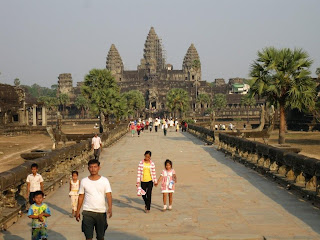
On our arrival in the capital, Phnom Penh, we started in true colonial style by going to the Foreign Correspondents Club (the place from which foreigners were evacuated when the Khmer Rouge seized the town in April 1975) and enjoyed some cheap but tasty cocktails.

After a bit of a monk drought in Vietnam, the orange cloaks are aplenty in Cambodge, so the last few days have allowed Penny to revisit her former hobby of stalking monks.


We had some very interesting walks around town. Phnom Penh means “Hill of Penh”, and the focal point of town is a temple on the small hill which houses some Buddha statues which washed up in the Mekong around 1000 years ago. On the hill little macaques run free, and a lot of money and energy has been poured into large parks and monuments.




The food has been quite a sensation. The local delicacy is “amok”, which appears to be a fancy way of saying “sensibly spiced curry”. This is a particularly stunning fish amok from a restaurant run by a former street kid, who was trained by a local charity.

We were a little bit shell-shocked after visiting the S-21 genocide museum and the killing fields, where we learnt about the Khmer Rouge’s brutal regime. Anything that makes you sit down in horror and cry should not be made light of, so we won’t even contemplate doing that. When the Khmer Rouge arrived in Phnom Penh in 1975, within three hours they performed a forced evacuation of the city, turning it into a ghost town. Currency was abolished and the reserve bank blown up. A city high school was turned into a torture centre. The Khmer Rouge wanted to execute all “new people” and start life at ‘Year Zero’. “Base people” were peasants, and “new people” were those who spoke foreign languages, were the educated (lawyers or doctors or intellectuals), or those who had soft hands or who wore glasses. They were tortured into giving the names of their colleagues, who were then also tortured and killed. There were many such prisons around the country. In S-21, 17,000 people entered its gates and 7 survived. Even the guards were replaced and killed by their replacements each year because they knew too much about its operations.
Some died there, and were buried behind a school building. Most were driven just out of town to a killing field where they were bludgeoned to death. Bones still litter the footpath and stick out from the soil. It was abhorrent. We took no photos, but will remember this site forever. Estimates of the death toll at the hands of the Khmer Rouge vary between 1.5 million to 3 million over a 4 year period, equating to about 20% of the Cambodian population at the time. The Khmer Rouge has left an indelible stain of poverty on this country – even without the shocking stories about 1975 to 1979, what we see each day makes us enormously thankful for the good fortune of being born an Australian.
So, jumping unnervingly quickly into pleasant stories again, while eating breakfast one morning we looked up and saw an elephant gently strolling down the street. We also saw it coming back the other way later that day.
On the second night we went to our guide’s house for dinner and ate ... tarantulas.


We visited a small truckstop / farming community where tarantulas are farmed the following morning. This young lass kept putting the tarantula on tourists in an effort to convince them to buy her pineapple. Only one dollar.

This girl is a rarity, because she is still smiling at us. Intrepid has a policy against passengers buying anything from children because it encourages them not to go to school. They refuse to take no for an answer. After Penny repeatedly refused to buy an 11 year old boy’s post cards, he waited outside our breakfast stall for half an hour and then told her “you lie to children lady” as she returned to the bus.
Then it was time for Angkor Wat, which is an enormous series of Khmer temples built between about 900 and 1150 AD. They were simply abandoned about 400 years ago and the jungle did a pretty good job of reclaiming the smaller temples, before the French re-discovered the sites between 1863 and 1914 and started rebuilding them. That marks quite a departure from the usual colonial approach of wrecking things.


One of the temples has 49 individual towers which faces carved out of stone on all four sides. Some are quite high – the tallest tower in the largest temple is 65m high, and these towers were around 40 metres above the ground, and were reached by scrambling up narrow stairs.



We also saw the temple where Tomb Raider III was filmed. The biggest gaggles of tourists were around the places where major scenes were filmed, and around a humorously shaped tree.








Hey! I'm currently in a 3-storey Apple store in Chelsea, on a giant computer. Freezing as hell outside. Haven't had time to read the blog properly, but the photos tell the story well! Love the coconut drinks - mmmm! Keep having fun - ttu soon :)
ReplyDeleteMichelle
Awesome! Sounds like you are having an awesome time guys. We are loving the blog!
ReplyDeleteThis comment has been removed by the author.
ReplyDeleteyou ate f-cking SPIDERS????
ReplyDeleteblog game over
you win
shutting mine down